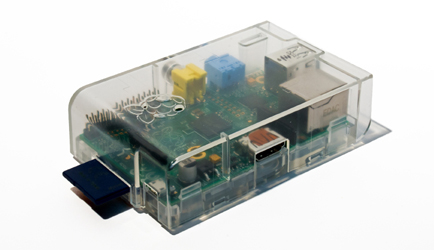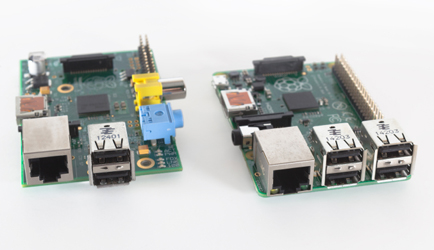The invocation of the ghosts of computers past is something Eben Upton, founder and chief executive of Raspberry Pi, does to reaffirm that computing belongs in Britain.
It’s easy to assume otherwise. Laptops, tablets, smartphones, desktop computers, almost anything with a microchip in it, are made in the Far East. The big Western names remaining in home computers are all headquartered in the US: IBM, Apple, Dell and Hewlett-Packard.
But, says Upton, there is an “amazing history” of computing in the UK. The man who is arguably the father of computing, Alan Turing, was British. The first operational computer to be used by people other than those who made it, EDSAC, the Electronic Delay Storage Automatic Calculator, was built in Cambridge.
Now, Upton is writing the next chapter of computing history, which in the spirit of British inventiveness is a cheap computer designed for tinkering with. Designed initially as a way to inspire children to study computer science, in just three years the Raspberry Pi has become a sensation, selling in its millions around the world. DIY ‘makers’ are using the cheap, basic, credit-card sized computer to build a bewildering array of devices at home, controlling motors and actuators, robots and mechatronics, while professional engineers are using it in their products and to control their factories.
Upton grew up during the UK’s personal computer boom in the 1980s, when idiosyncratic and affordable computers such as the ZX Spectrum, Amstrad CPC and BBC Micro opened up computing to millions of households. The computers, which featured programming languages designed for beginners, are credited with inspiring a wave of youngsters to go into software engineering careers.
Upton, who owned a BBC Micro, believes the effect was more far-reaching. He says: “It was a wonderful route to get people into engineering. Not just software engineering, but all types. A software engineer needs the same basic skill set as a mechanical or civil engineer – computational, logical, problem-solving skills. It helped inspire a whole generation of engineers.”

Educational need
The Sinclair Spectrums and BBC Micros ceded the UK home computer market to the PC during the 1990s. PCs offered a much less accessible and open programming environment. Children also moved on to closed console gaming systems, such as those made by Nintendo or Sega. When Upton began teaching computer science at Cambridge University in 2005, he noticed a fall in the number of applicants, then in the number of graduates. The British wave of 1980s home computing had washed away, and left a rapidly drying up pipeline of talent, just as the demand for engineers was growing exponentially.
Upton decided the solution was to inspire a new generation of engineers, and that the way to do this was to develop a cheap, robust, programmable computer. Just as those 1980s computers did, the Raspberry Pi can plug into your TV or monitor, and lets people try programming with accessible languages, such as Scratch and Python.
The Raspberry Pi was launched in 2012 and has been a massive hit, with sales surpassing everybody’s expectations. Upton was expecting the device to sell thousands, maybe 10,000. To date, more than 6 million Raspberry Pis have been sold. The factory in Wales where they are made regularly works at its production capacity of 20,000 units a day. Upton is as surprised as anyone at the explosion in demand.
“We were building a toy,” he says. “A cheap, robust, fun and programmable computer to inspire kids into engineering. We didn’t set out to build an industrial controller. But, it turns out, it has uses outside of being a toy.”
Engineers are using Raspberry Pis as a cheap, quick way of giving a product internet connectivity, or to automate and monitor factory equipment. The device has also created a burgeoning online DIY ‘maker’ community of enthusiasts.
Upton says: “It turns out that we didn’t need to create demand. The demand is already there. The world is full of people with ideas – we are enabling them to fulfil them. Raspberry Pi is like glue or Lego: it lets people glue things together when they might not have the skills or knowledge to do so otherwise.”
Upton says the recent upsurge in sales is being driven by industrial applications, which represent two million of the six million units sold. Raspberry Pi was initially formed as a charity, but last year a company was launched alongside a new version of its device, the Compute Module, to cater better for the industrial market. The move was partly a response to demand, and partly a response to feedback on the device, he says.
The Compute Module is six times more powerful than the original version, with a smaller form factor, and the capability for the location of the ports and interfaces to be determined by the engineer. “These are things that make it easier for a mechanical engineer to design a product or device with a Raspberry Pi embedded inside it,” says Upton.
In addition, the company recently launched a customisation service. If your product is successful and produced in large volumes, the Compute Module can be ordered to your specification, removing the need to modify it, such as by adding interfaces and changing the form factor, in your own manufacturing process. This turnkey solution is offered via Raspberry Pi’s website. “We say in the office, it’s the internet of things – the internet of things big enough to fit a Raspberry Pi in,” says Upton. “The Compute Module is really just the brains of the Pi. Then the customisation service lets you move from making tens of something to thousands of something.”
There has been some criticism of the use of Raspberry Pis in an industrial environment. There is a world of difference between a hobbyist project and a managed, high-volume industrial process. Many of these issues were addressed in last year’s updated Compute Module. But Upton denies that the cheapness of the Pi makes it less reliable. “We are disrupting the market,” he says. “The incumbents don’t sell many units. Our platform is under a lot of scrutiny. It has literally millions of eyeballs on it. In terms of stability and proving reliability, it doesn’t get much better than that.
“But it’s true that there are limitations in terms of feature set. It doesn’t have CANbus, it doesn’t meet a number of standards, there is no analogue input. But people use add-ons.”

Fast learning curve
There is a more subtle aspect to the Raspberry Pi for a professional engineer. It undeniably provides a great way to expand your knowledge and skill set into embedded systems and software engineering. For a mechanical engineer to become an embedded hardware systems engineer might take up to five years. Buying a Raspberry Pi and learning enough of the programming language Python to get by can take as little as two months. Indeed, the Pi in the name “Raspberry Pi” is taken from the programming language. The device was inspired by the Python programming language.
By making the problems more accessible, the Raspberry Pi cunningly broadens the number of engineers who can approach the challenge of embedding electronics and software into a device. Upton says: “It turns the hardware problem into a software problem. Only a small number of people can do embedded hardware. It’s hard. But a much broader number of engineers can do software.
“By removing that clique of people who can solve the problem, and giving the person with the problem the means and tools to fix it themselves, it gets done quickly and in more areas.”
So has Upton achieved his initial goal of inspiring a new generation of engineers? From a parochial point of view he says it’s mission accomplished. The number of applicants to study computer science at Cambridge is back up at 800 a year again. He estimates that 2 million Raspberry Pis have been sold for use in education. But the Pi will keep going.
“We’re back to where we were in the 1980s, in just three years, so I’m pleased with that,” says Upton. “But, let’s face it, maybe 1% or 2% of children, boys, went on to Stem careers because of those 1980s computers. I want to get up to 30% involved in this, without the gender divide.
“The big opportunity is to broaden the reach, to go out to the kids who care most about subjects like art or cooking, and say to them, you can do more things, interesting things, with this.”
The plan also incorporates an international outlook. Some 80% of Raspberry Pis are exported. Although the project was started to inspire British youngsters to become engineers, Upton has no problem inspiring kids all over the world, and sees “massive opportunity in Asia and South America”. Despite the growing industrial side of the business, it’s heartening to see that educational outreach remains at the core of Raspberry Pi, and at the core of Upton as well.
DIY Raspberry Pi
Millions of people have discovered that one of the best ways to get started with Raspberry Pi is with a home DIY project.
The variety of possible projects is staggering, ranging from straightforward computing applications such as word processing, media streaming or video gaming, to data acquisition, home automation, robotics, or even smart beer fridges.
Thousands of well-documented sets of instructions and messages of inspiration, with people willing to offer help and advice, can be found online.
Eben Upton, chief executive of Raspberry Pi, suggests selecting a project in an area that already interests you in the first place. He gives the example of photographer David Hunt’s adaptation of an old flat-bed scanner, Raspberry Pi and digital camera into an alternative to a range of expensive “macro photography” equipment.
Macro photography, producing photographs of small items larger than life, such as is done in various nature TV programmes, can cost many hundreds of pounds to achieve with an array of camera equipment. But Hunt found and took apart an old flat-bed scanner, attached a camera to the linear actuator on it, then attached and programmed the Raspberry Pi to it to move the camera closer and closer to the object. The Pi also ran free software to achieve focus stacking, assimilating hundreds of subtly different photos into a highly detailed single picture. The results are stunning photographs that would otherwise have cost hundreds of pounds to achieve.
For more examples of projects and Pi starting points, see imeche.org or download the PE app.